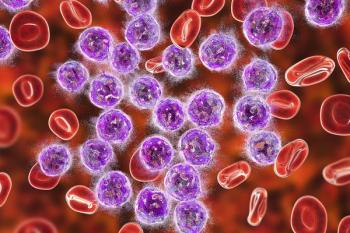
Post-Immunochemotherapy Radiotherapy Is Unnecessary in Some DLBCL Cases
Adjuvant radiotherapy for diffuse large B-cell lymphoma is unnecessary for elderly patients who have PET-negative bulky disease following immunochemotherapy.
CHICAGO-Adjuvant radiotherapy for diffuse large B-cell lymphoma (DLBCL) is unnecessary for elderly patients who have positron emission tomography (PET)-negative bulky disease following immunochemotherapy, according to an interim analysis of the phase III OPTIMAL>60 clinical trial (abstract
“A planned interim analysis of OPTIMAL>60 confirmed that a PET-based radiotherapy strategy to bulky disease is safe,” reported lead study author Michael Pfreundschuh, MD, of the University Saarland Medical School in Homburg Saar, Germany. “This strategy results in a 42% reduction of radiotherapy without compromising the outcome of these patients.”
Radiotherapy for PET-positive bulky DLBCL after immunochemotherapy “appears to compensate for the assumed worse prognosis,” Pfreundschuh noted.
Radiotherapy targeting bulky DLBCL sites in elderly patients improves outcomes overall but the research team sought to determine whether patients with PET-negative disease can be safely spared irradiation after immunochemotherapy with rituximab plus cyclophosphamide, doxorubicin, vincristine, and prednisone (R-CHOP).
They enrolled patients diagnosed with CD20-positive DLBCL at age 61 to 80 years and randomly assigned them to receive 6 cycles of CHOP or CHLIP (substituting 2-mg conventional vincristine with 2-mg/m2 liposomal vincristine) plus 8 cycles of rituximab (375 mg/m2 every 2 weeks or on a 12-day dosing schedule starting 4 days before CHOP and extending to day 238). Patients with PET-positive bulky disease received 39.6-Gy radiotherapy after chemotherapy.
The authors used a historical comparison group from the RICOVER-60 study in their analysis. Median patient age, extranodal disease involvement, ECOG performance status scores, and other variables varied significantly between RICOVER-60 and OPTIMAL>60, Pfreundschuh cautioned.
Less than half (48%) of patients in OPTIMAL>60 who had PET-positive disease underwent radiotherapy. The reasons for foregoing radiotherapy for PET-positive disease included progressive disease (44%), toxicity and “medical reasons” (50%), and “other” (6%).
Overall, 33% of OPTIMAL>60-enrolled patients underwent radiotherapy, compared with 57% for RICOVER-60-a 42% relative reduction in radiation treatments. Yet, progression-free survival rates were comparable between OPTIMAL>60 and RICOVER-60 trial participants (79% vs 75%, respectively; P = .60, n.s.). Overall survival was also similar (88% vs 78%; P = .31, n.s.).
Newsletter
Stay up to date on recent advances in the multidisciplinary approach to cancer.
































































































